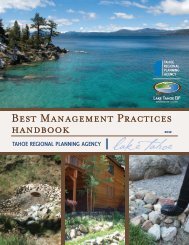4.4-b BIOSWALE DESCRIPTION APPLICABILITY ... - Tahoe BMP
4.4-b BIOSWALE DESCRIPTION APPLICABILITY ... - Tahoe BMP
4.4-b BIOSWALE DESCRIPTION APPLICABILITY ... - Tahoe BMP
Create successful ePaper yourself
Turn your PDF publications into a flip-book with our unique Google optimized e-Paper software.
• Can be incorporated into a number of different landscape settings, such as<br />
front and back yards of residential areas, road shoulder rights-of-way, and in<br />
connection with roof downspouts.<br />
• Slows the rate of runoff compared to other types of impervious drainage<br />
systems such as curb and gutter and storm drain pipes.<br />
Disadvantages<br />
• May require irrigation to maintain vegetation.<br />
• Unless pretreatment is provided, applicability is limited to sites with low<br />
sediment loads.<br />
• Once clogged, restoration typically requires rebuilding the system.<br />
DESIGN CONSIDERATIONS<br />
• Swale bottoms should be relatively flat with a longitudinal slope around 1-3<br />
percent. Where existing topography dictates slopes greater than 3 percent,<br />
check dams or a series of terraced bioswales shall be used to reduce the slope of<br />
the swale.<br />
• The maximum ponding in the swale should be 6 inches.<br />
• Amended soil should typically be 12 to 18 inches thick within the bioswale. The<br />
top 6 inches of amended soil should contain sufficient organics and nutrients to<br />
promote and sustain vegetation establishment.<br />
• Consider designing an accessible sediment trap or an equivalent pretreatment<br />
device at the inlet of a bioswale for removal of coarse sediment and debris.<br />
Accessible maintenance facilities can markedly improve the ease of maintenance<br />
and contribute to extended effectiveness.<br />
• An underdrain may be used to improve filtration rates.<br />
• Design freeboard (distance between top of water at peak flow to top of channel)<br />
to be at least 6 inches, but preferably 12 inches.<br />
• In swales wider than 4 feet, consider using level spreaders at the head of the<br />
swale and every 50 feet in the channel.<br />
• Direct runoff into bioswales either as concentrated flow or as lateral sheet flow.<br />
Provide sufficient energy dissipation for concentrated flow prior to discharge to<br />
the swale. If flow is directed into a swale from curb cuts, make curb cuts at least<br />
12-inches wide to prevent clogging.<br />
• Select native vegetation and provide a dense and diverse selection of lowgrowing<br />
plants. For bioswales that will not be irrigated or sited within naturally<br />
wet areas, selected drought tolerant vegetation. If permanent irrigation will be<br />
used, a wider selection of plants will be available.<br />
• Consider incorporating trees or shrubs along bioswales to aesthetically integrate<br />
the design with the landscape.<br />
INSTALLATION CONSIDERATIONS<br />
• Prior to swale construction, stabilize the drainage area to the facility with<br />
temporary <strong>BMP</strong>s to keep runoff and sediment from entering the swale.<br />
• Scrape away and stockpile any organic topsoil for later use prior to excavating.<br />
Chapter 4: <strong>BMP</strong> Toolkit<br />
TRPA <strong>BMP</strong> Handbook<br />
<strong>4.4</strong>-b Bioswale May 2014<br />
Page 12
















